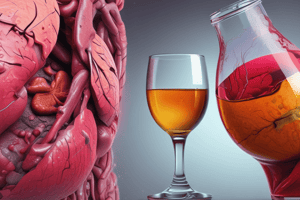Podcast
Questions and Answers
What primarily triggers the increase in renal sodium retention in the Overflow Theory?
What primarily triggers the increase in renal sodium retention in the Overflow Theory?
- Increased oncotic pressure
- Compression of hepatic sinusoids
- Increased plasma volume (correct)
- Decreased portal venous pressure
What characterizes the Underfill Theory of ascites formation?
What characterizes the Underfill Theory of ascites formation?
- Expansion of effective plasma volume
- Decrease in plasma volume due to renal loss
- Increase in intravascular fluid compartment
- Secondary renal sodium retention due to reduced intravascular fluid (correct)
Which factor is NOT associated with the Peripheral Arterial VD Theory?
Which factor is NOT associated with the Peripheral Arterial VD Theory?
- Increase in vascular capacity
- Decrease in effective plasma volume
- Secondary renal sodium retention
- Increase in portal venous pressure (correct)
Which process occurs when ascites formation begins according to the Underfill Theory?
Which process occurs when ascites formation begins according to the Underfill Theory?
How does portal hypertension relate to fluid accumulation in cirrhosis?
How does portal hypertension relate to fluid accumulation in cirrhosis?
Flashcards
Portal Hypertension - Fluid Accumulation
Portal Hypertension - Fluid Accumulation
Increased fluid within the liver's blood vessels (sinusoids) due to congestion.
The Overflow Theory
The Overflow Theory
A theory explaining ascites formation where a stimulus from the liver triggers increased blood volume due to the kidneys holding onto more sodium.
The Underfill Theory
The Underfill Theory
A theory of ascites formation where the body responds to fluid loss by reducing blood volume, leading to increased water retention by the kidneys.
The Peripheral Arterial VD Theory
The Peripheral Arterial VD Theory
Signup and view all the flashcards
Ascites
Ascites
Signup and view all the flashcards
Study Notes
Pathogenesis of Cirrhosis
-
Portal Hypertension: Excess fluid formation in congested hepatic sinusoids, overwhelming intrahepatic lymphatics, leading to fluid leakage across the liver.
-
Overflow Theory: Liver-derived stimulus causes a primary increase in plasma volume due to increased renal sodium retention.
-
Underfill Theory: Ascites formation leads to intravascular fluid compartment shrinkage, increasing plasma oncotic pressure and decreasing portal venous pressure. This triggers secondary increase in renal sodium retention.
-
Peripheral Arterial VD Theory: Increased vascular capacity and decreased effective plasma volume cause secondary increase in renal sodium retention.
Studying That Suits You
Use AI to generate personalized quizzes and flashcards to suit your learning preferences.




